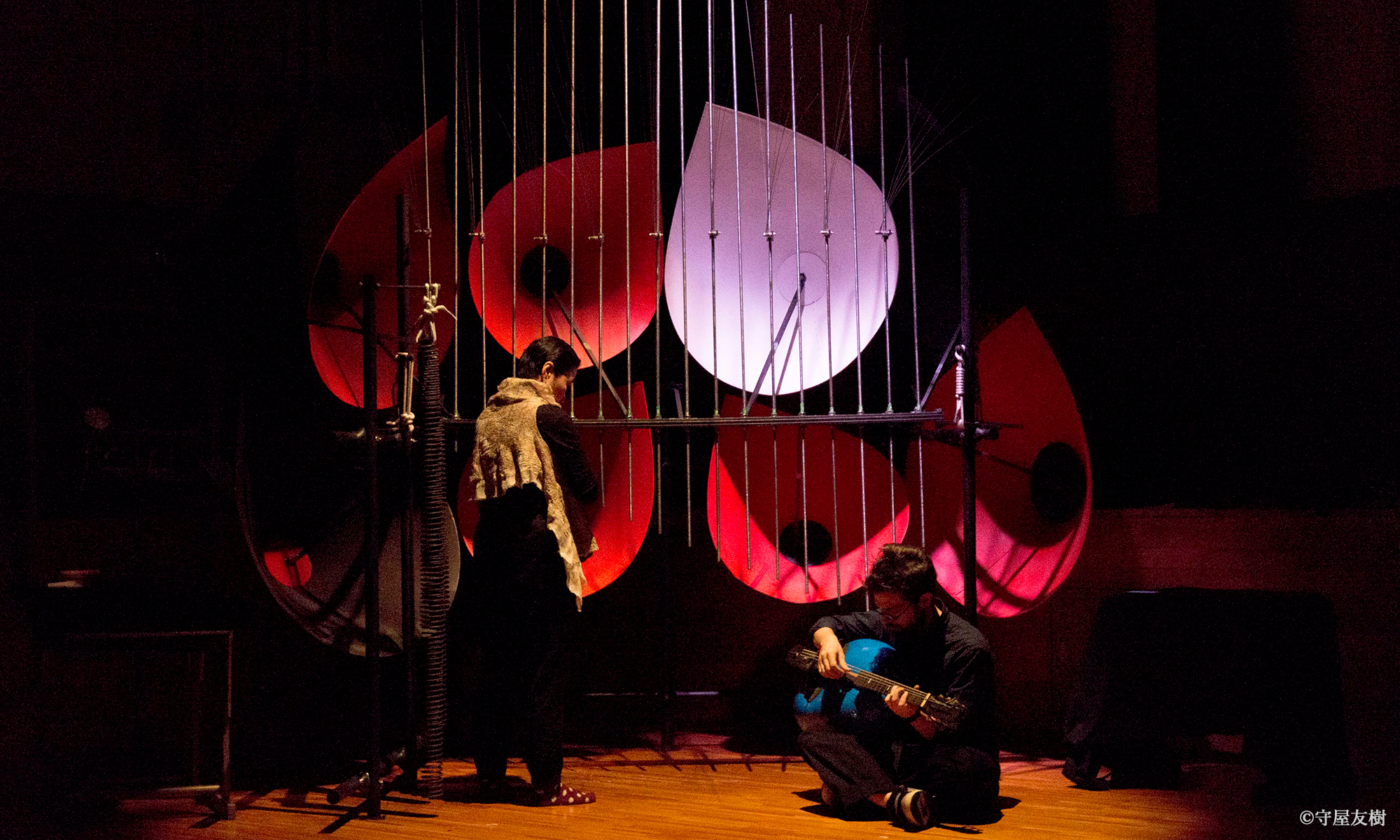KATSUHARAPHONE in Concert at Tokyo Geidai
Martí Ruids マルティルイツ & Sachiko Nagata 永田砂知子

↓↓↓音源はこちらのリンクから無料で聴くことができます。↓↓↓
2017年東京芸術大学・取手キャンパス・藝大ファクトリーラボで行われたマルティ・ルイツと永田砂知子の演奏による勝原フォーン・コンサートの音源がバンド・キャンプで公開されました。このコンサートは勝原フォーン修復のためのクラウドファンディング出者者向けのコンサートでした。音源公開を許可してくださった東京藝術大学バシェ修復プロジェクト関係者の皆様、出資してくださった皆様へ感謝します。以下は、勝原フォーン修復に携わり、演奏をしたマルティ・ルイツさんからのメッセージです。フランソワ・バシェ生誕100年目をお祝いに間に合うように2020年12月31日にリリースされました。
2017年、東京藝術大学は、バルセロナ大学バシェ音響彫刻工房を代表して来日したマルティ・ルイツと日本バシェ協会の協力のもと、バシェ音響彫刻修復プロジェクトの一環として「勝原フォーン」の修復を行いました。このコンサートは、2017年12月2日に芸大ファクトリーラボにて、勝原フォーンの修復を可能にしたクラウドファンディング出資者へのコンサートとして開催されました。
日本のバシェの音響彫刻は、1970年日本万国博覧会・鉄鋼館ディレクターを務めた作曲家・武満徹氏に招かれたフランソワ・バシェとアラン・ヴィルミノによって1969年に17点の作品が制作されました。それぞれの作品には日本の助手にちなんだ名前が与えられました。万博終了後、作品は解体され、倉庫で眠っていました。2010年に鉄鋼館がEXPO’70パビリオンとしてリニューアルオープンした際に池田フォーンが修復。2013年に万博当時助手を務めた川上格知(かわかみ まさとし)氏の兵庫県穴栗市のアトリエにて川上フォーンと高木フォーンが修復されました。2015年京都芸術センターと京都市立芸術大学の協力を得て渡辺フォーン、桂フォーンが修復されました。
そして2017年、川崎義博氏が中心となり、東京藝術大学先端芸術表現科・古川研究室と、藝大ファクトリーラボとの共同チームで、修復プロジェクトが行われ勝原フォーンが修復されました。マルティ・ルイツは、2013年、2015年、と修復のために来日し、永田砂知子と共にバシェ音響彫刻を演奏してきました。かつてバラバラに散らばっていた勝原フォーンの形と機能を取り戻し、我々が50年の沈黙後の初録音をお届けできることを光栄に思います。
勝原フォーンは、日本の琴を彷彿とさせるチターのような部分と、ハープや、竪琴のような部分でできいて、コーンと呼ばれる大きなアルミ製のスピーカーから音が放射されています。この複合システムは、3オクターブの半音階を持つ大きな平板のチターのような金属弦板部分と、4本の弦を非対称な半音域に折り曲げた3本の直立した竪琴の部分から構成されており、8つの音程を得ることができます。この実験的な直立した弦のセットは、オリジナルのバシェのローリングブリッジを使って曲げられており、トレモロアームは弦の半分を高い音程に引き上げると同時に、もう半分の弦の音程を下げることができます。また直立した竪琴の1つは、三味線やインドのシタールにある「サワリ」のような、ひずみの音がうなり声を上げる仕掛けも備えています。
このアルバムには、芸大ファクトリーラボで勝原フォーンを修復しながら、パーツを繋ぎ直したり、新しい弦をセットしたり、ナットやボルトを交換したり、固定したり、ベストなセッティングを推測したりしているうちに思いついた音楽が収録されています。この一連の作業は、何十年も前から耳にすることのなかった音と混ざり合い、バシェがいつも行っているように、直接体験することで探求と発見へと私たちを誘う、美しく、感動的なプロセスでした。私たちは発見したものをとても気に入っています。弦の音の一つ一つが、金属製のスピーカーの共鳴によって、結晶のように、あるいはオーバードライブされて、時代を超えて生きてきた命を運んでいます。その音が現代に蘇るのを目の当たりにするのは、まるで龍の静謐な存在を覚醒させるようでした。
バシェのサウンド体験に不可欠な好奇心と寛大さに駆られて、このような出会いの喜びと情熱を分かち合えたことを嬉しく思います。勝原フォーンの修復とコンサートを実現させてくださったクラウドファンディング参加者の皆様、修復にご協力いただいたすべての皆様に感謝申し上げます。
2020年はフランソワ・バシェ生誕100周年、1970年の日本万国博覧会から50周年の節目の年であり、それを記念した展覧会が川崎市の岡本太郎美術館で開催されていましたが、Covid19によって会期が大幅に縮小され打ち砕かれてしまいました。この録音のリリースは、かつて大阪万博’70のバシェ音響彫刻がもたらした多くの美しいもの、音響彫刻の周りで起こった、そして今も置き続けている多くの人々の体験のすべてを讃えたものです。
それを可能にしてくださった皆様に感謝します。バシェオロジーと世界の平和に万歳。
補足(永田)・この時のコンサートでは、横弦にマルティ・ルイツ自作の特別なダンパーが装着された。それにより、日本の伝統的な音階・陰旋法による音楽となっている。
2020年12月
マルティ・ルイツ 永田砂知子(日本語訳・永田砂知子)
・・・・・・・・・・・・・・・・・・・・・・・・・・・・・・・・・・・・・・・・・
In 2017, the Tokyo University of the Arts organized the restoration of Katsuharaphone as part of the Baschet Restoration Project, in collaboration of the Baschet Association of Japan and Martí Ruids Phd, on behalf of the Baschet Soundsculpture Workshop from the Barcelona University. This concert was held at Geidai Factory Lab on December 2nd 2017, as a concert for the crowdfunding investors who made it possible to restore Katsuharaphone.
The Baschet sound sculptures in Japan were created in 1969 by François Baschet and Alain Villeminot, invited by the renowned composer Toru Takemitsu, director the Japanese Steel Pavilion of the 1970 Osaka World Exposition, naming each piece after the Japanese assistants. After the Expo the pieces were dismantled and slept in a warehouse. Ikedaphone was restored when the Steel Pavilion reopened as the EXPO’70 Pavilion in 2010, Kawakamiphone and Takagiphone in 2013 in the forest house of former asistant Masatoshi Kawakami by Shiso City in the Hyogo prefecture, Watanabephone and Katsuraphone in 2015 with the collaboration of the Kyoto Art Center and the Kyoto City University of Arts. Katsurharaphone was then restored in 2017 in Tokyo Geidai, with the precious impulse of professor and sound artist Yoshihiro Kawasaki. Sachiko Nagata and Martí Ruids have played the Baschet sound sculptures for each restoration. It is an honor to offer you the first recording after 50 years of silence, having brought back the entire Katsuharaphone, once spread in pieces, back to its shape and function.
Katsuharaphone is actually a system of harps, or lyres, zithers, reminiscent of the Japanese koto, all radiated by big aluminium speaker cones. The compound system comprises a big flat zither-like metal string board with three chromatic octaves range, and three upright lyres, with four strings each, bent into asymmetric halves -so eight pitches are obtained- in pairs of strings sharing tension. This experimental sets of upright strings are bent against an original Baschet rolling bridge with a tremolo arm able to simultaneously pull half of the strings to a higher pitch while dropping the other half down in pitch, allowing for subtle tremolo textures, expressive tone inflections, detunings and wild whammy bar dive bomb effects. One of the upright lyres also features an adjustable buzzing-roaring bridge piece, similar to the Sawari in Shamisen or the Jivari Indian Sitar.
This album contains the music that came to us while restoring the Katsharaphone at the Geidai Factory Lab, reconnecting the parts, setting new strings, replacing nuts and bolts, fixing and guessing the best settings. That collective effort was a beautiful and inspiring process that mixes with the sounds -unheard for decades- inviting us to explore and discover, by direct experience, as the Baschet always do. We loved what we found. Each of the string sounds, crystalline or overdriven by the resonance of the metal speakers, carries a life that lived through times. Witnessing the sounds coming back to our current days was like awakening the serene presence of a dragon.
We are pleased to share the joy and the intensity of this kind of meeting, driven by the curiosity and generosity essential to the Baschet sonic experience. We would like to thank all the crowdfunding participants for making the restoration and concert of Katsuharaphone possible, and all the people who cooperated in the restoration.
2020 is the 100th anniversary of Francois Baschet’s birth and the 50th anniversary of the 1970 Japan World Exposition, and an exhibition celebrating it was held at the Taro Okamoto Museum of Art in Kawasaki City, but it was shattered by Covid19. The release of this recording is a celebration of all the many beautiful things that the Baschet sound sculptures from EXPO Osaka‘70 once brought to life, the many personal experiences that took place, and still take place around the sound sculptures. Thanks to everyone who makes this possible. Long live to Baschetology and peace in the world.
December 2020
Sachiko Nagata and Marti Ruids

